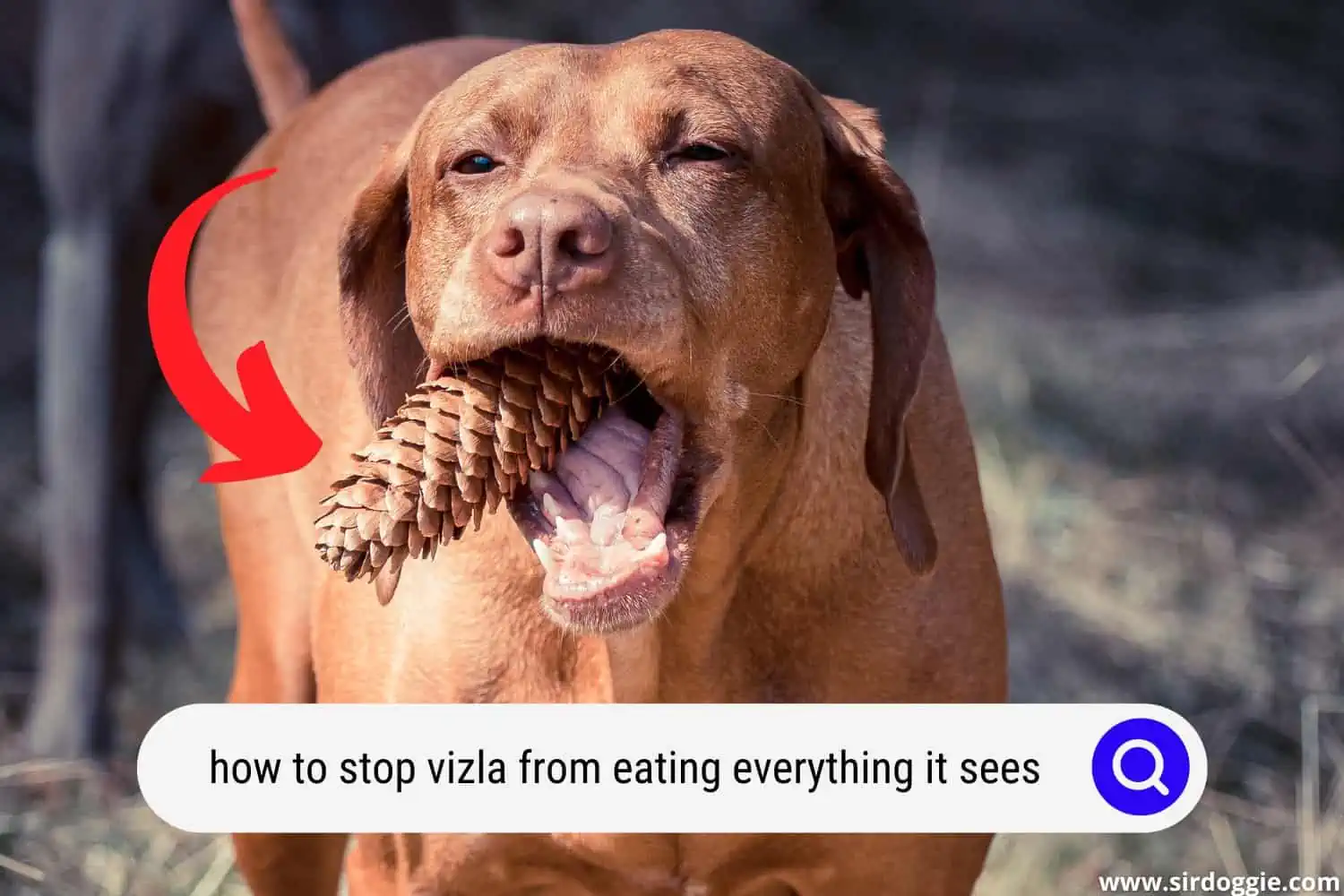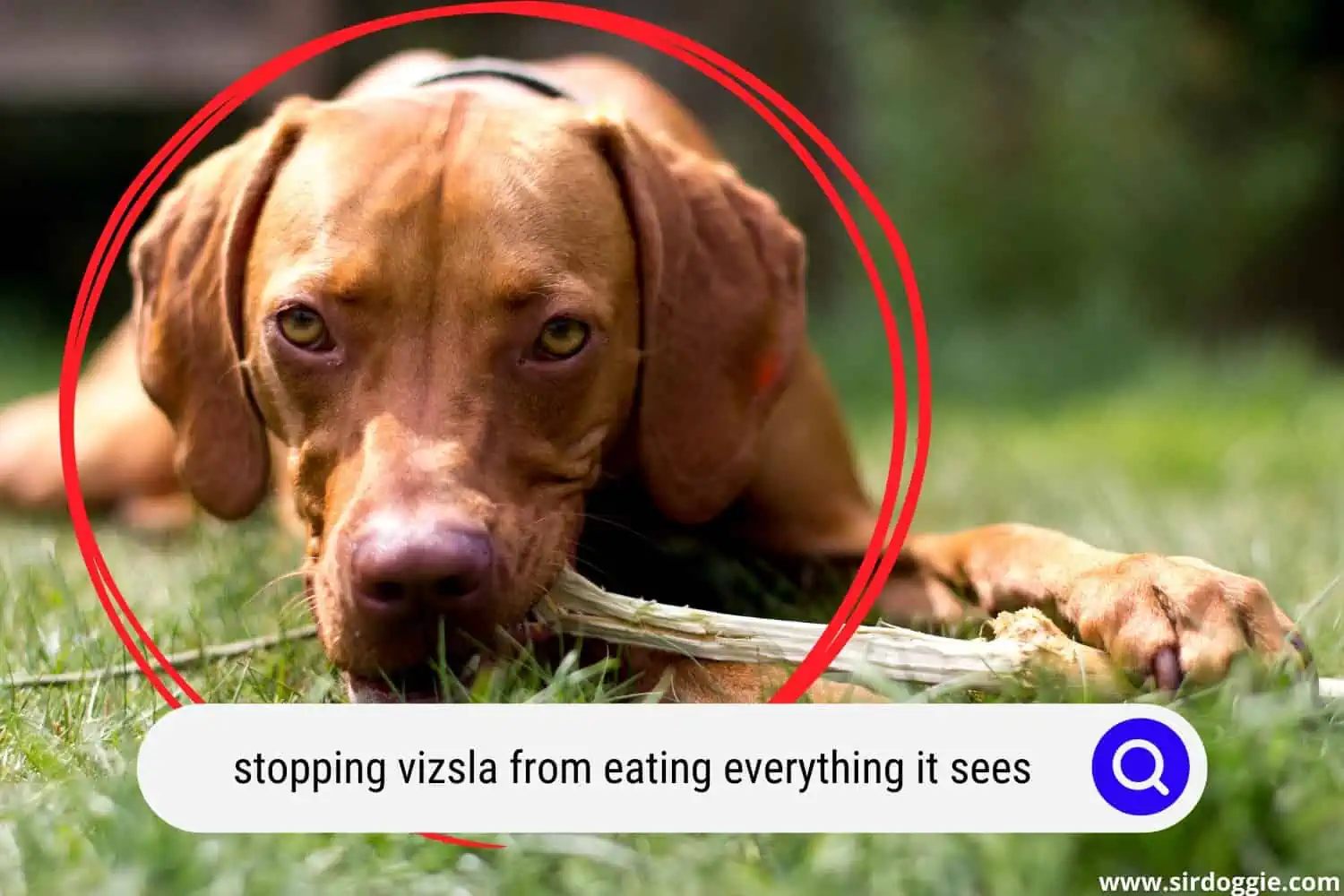How to Stop a Vizsla Dog from Eating Everything It Sees?
Training your dog not to eat anything it finds on the street is very important. It is very useful to avoid possible incidents, such as poisoning or discomfort, related to digestive problems. Therefore, it is necessary that you find out what solutions are required to help you prevent and solve this problem. In addition, thanks to all this, you can have a healthy dog and avoid unnecessary visits to the vet.

A fairly common problem that dog owners have to solve is pica syndrome, which is the ingestion of things and objects that are not part of a dog’s diet.
When we talk about this syndrome, we are referring to the classic events of puppies and adult dogs eating and chewing socks, plastic toys, shoes, and anything else that is around them.
Pica syndrome is a compulsive disorder that not only spoils your objects but can also endanger your Vizsla dog. Inappropriate items for feeding your canine can cause a bowel obstruction that could lead to a medical emergency. Even if your Vizsla tries to eat electrical wires, it can get an electric shock.
How Can I Prevent My Vizsla Dog from Eating Everything It Sees?
In this case, you should constantly train your dog, since it is not something that you can avoid from one day to the next. There are a series of methods, steps, techniques, and tools to use to help you achieve your goal and thus promote your dog’s health and protection.
Materials Needed for Training Exercises with Your Vizsla Dog
- One short and one long strap.
- A dog collar.
- A small cord.
- Rewards (kibble, treats, etc.)
- Trap objects: ham, feed, cheese, bread, bacon, yogurt, salami, banana skin, handkerchiefs, socks, etc.
Methodology
It is essential to mention that when your dog has learned not to take a specific object (such as a sock or shoe), it would be a good idea to choose several trap objects to create a generalization. That is necessary so that your dog learns not to eat anything it finds (either on the floor of your house or in the streets). It is more effective to teach it not to catch the first thing it sees with its eyes through a series of traps.
You have to train your Vizsla in different places such as the backyard of your house, parks, beaches, dog play centers, and even in the parking of any commercial establishment. That way, it will adapt to obey you anywhere.
Four methods to teach your Vizsla dog not to eat anything from the ground in the street are the following:
Method 1: Use the Short Leash
- The first thing you have to do is tie the short leash to your dog’s collar.
- You must leave the trap objects (shoes, plastic toys, socks, etc.) on the ground.
- Take the leash of your Vizsla and walk with it right next to the trap objects. Remember to keep your canine on the leash firmly in case it wants to run away.
- When your Vizsla dog wants to grab one of the trap objects, say “No!” pulling the leash up. Repeat this step as many times as necessary.
- If the canine has done a good job, call it by name and reward it with a treat.
Method 2: Use the Long Leash on Your Hand
- Take the long leash and tie it to your dog’s collar.
- Spread the trap items you are going to use around the room or area where you are.
- Allow your Vizsla to go and surround the entire area. Through this, it will be able to sniff and look at all the trap objects on the ground.
- When your dog wants to grab one of the objects on the ground, say “No!” and pull the leash towards you.
- Allow it to go back through the area on its own. In case you want to grab the items, pull the leash a second time.
- If your Vizsla dog does not catch the trap objects anymore, call it and reward it with some treats.
Method 3: Work with the Long Leash and the Small Cord
- First, make sure you are in a place that is spacious enough for your Vizsla dog to move freely.
- Choose the number of trap objects you want and place them on the ground.
- Take the long leash and the small cord and tie them to your Vizsla dog’s collar.
- Release your dog and allow it to move around the place.
- When your canine wants to grab one of the trap objects on the ground, say “No!” and go to it to punish it by pulling the little cord (if your dog escapes when you go to punish it, step on the long leash).
- Let your Vizsla go again.
- If your dog doesn’t catch the trap objects again, reward it with some treats while saying some positive words such as “good job” or “great boy.”
Method 4: Apply the Commands
Step 1
- Prepare lots of treats for your dog (especially the ones it likes best) and keep them by your side.
- Take a treat in your hand and get closer to your dog, crouch down and allow it to smell and lick the treat, but don’t let it eat it.
- Close your hand and watch your dog’s reaction. Some dogs even bark in despair, but the important thing is to wait for the moment when your canine stops looking at your hand.
- When your dog looks directly at you, say “Yes” and give it the treat. That is a positive reaction for your Vizsla, so you must be consistent in this exercise.
- Repeat this several times, waiting for the moment when it turns its attention to you and rewarding it when it does.
If your Vizsla has successfully completed the first step, proceed to the second step.
Step 2
- Put a treat on the ground near your foot and watch your Vizsla.
- When your dog wants to get close to you, put your foot on or in front of the treat and say “Drop it” or “Drop it” (choose one so you don’t confuse it by using both).
- Your dog will surely get close to your foot. Be patient and wait for it to step aside.
- When your Vizsla does, say “Yes” and reward it for good behavior.
- Eventually, your dog will learn that if it hears “Drop it” or “Let it go,” what it has to do is turn to look at you and not grab what is on the floor.
Thus, on a day-to-day basis, when you tell your Vizsla the command, its reaction will always be to stop or come to you instead of running to grab what is on the floor.
Remember that training is not a matter of one day. Your dog will understand this quickly, but you must continuously reinforce it so that it does not forget.
Recommendations to Prevent Your Vizsla Dog from Eating Anything It Sees
Identify the Cause
Finding the reason is the first thing to solve this problem. If your Vizsla is around a lot of chewy objects most of the time at home, you should allow it outside to help stop this behavior.
Use Games to Entertain Your Dog
Distraction is vital for your dog, especially if it is prone to eating all the things it finds. Create a place in your house to play and have fun with your Vizsla, as it is an excellent option to stimulate the area around a bored dog with toys and exercises that help it mentally forget about its bad behavior.
Keep Dangerous Objects Out of Reach
Having dangerous objects for the health of your Vizsla scattered throughout your house is very serious. Dogs don’t think when they grab, eat, or chew anything they see on the ground. However, you can avoid this by hiding objects out of your canine’s sight.
Objects such as strings and ropes are especially dangerous to the health of your Vizsla dog’s digestive system.

Don’t Throw Your Food on the Floor
Feeding your Vizsla with the food you are eating for breakfast, lunch, or dinner will only confuse it even more.
Reward It Appropriately
When your Vizsla does something right, and you want to give it a gift, don’t throw the reward on the floor. Give it directly to its mouth.
Don’t Let It Clean the Floor with Its Tongue
Telling your dog to eat food that has fallen on the ground is a mistake. If you want to feed it that, then pick it up and put it on its food plate for it to eat from there.

Family Dog Expert Author
Hi there! I’m Stuart, a devoted dog lover and family dog expert with over a decade of experience working with our furry companions. My passion for dogs drives me to share my knowledge and expertise, helping families build strong, loving bonds with their four-legged friends. When I’m not writing for SirDoggie, you’ll find me hiking, playing with my beautiful dog, or studying music.